| Transcend USA TV-Box 2.0 TV Tuner - Page 2 0f 3 |
Installation:
The physical installation involved the connection of 4 cables (need to connect a fifth cable for capture from s-video/composite) and is as pictured below.

All-in-all, you're talking about a few minutes to have the device hooked up and ready to go. The obvious advantage over a PCI slot tuner card is that you don't have to power down your system, open your case, or hope you have a free PCI slot to use. Along those same lines, there is nothing stopping you from sharing the TV-Box with several computers... Making it easy to bring on trips, to the office, and unlike a PCI slot card, it can go anywhere a laptop owner may want to go.
The system that the TV-Box is being installed on for this review consists of the following components:
• Pentium 4 2.6C processor
• Abit IS7-G i865PE motherboard
• (2) Seagate 80GB S-ATA hard drives in RAID-1
• Gigabyte Radeon 9600XT AGP card
• Windows XP Professional with current updates
The software installation started equally well, but encountered one small snag. I ran the installation application on the included cd, and it lead me through a series of confirmations, not unlike any other installation. Once complete, the system needed to be rebooted, and I thought we would be ready to go. When I clicked to launch the application I was informed there was no device present despite it being physically installed properly, and with what I thought was a successful software install. I relaunched the software a few times to no avail, and rebooted the system once again... still nothing. Unplugging the USB cable and immediately plugging it back in triggered Windows XP to launch an installer that added drivers for a 'USB 2800' device. With that unexpected step complete the device was now detected and I had cable television on my screen!
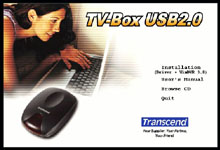
The screen capture below shows the main interface for viewing / controlling the TV. The software is called InterVideo WinDVR 3, and the GUI looks a bit like a modern VCR or cable box. As pictured below, there is the main control area (with optional panel expanded on the right for reference) as well as a viewing window where the programs show. This Window is scalable at preset sizes (320x240, 640x480, and Full Screen), or the corner can be dragged and sized to the user's preference. One feature I didn't care for was that you can not minimize the control window without minimizing the viewing window as well. Something the Leadtek WinFast TV 2000 XP Deluxe does that I have grown fond of for when desktop real estate becomes scarce.

One letdown is shown as a greyed out box above... A button labeled EPG (Electronic Programming Guide) is described as being comparable to a feature of my Leadtek card which I find quite useful, but unavailable here. If it is truly comparable, EPG is supposed to allow access to an internet database of television programs and allow the user to schedule recordings by clicking around this web page. The Leadtek software interacts with Titan TV, and sadly I can not report on what the TV-Box may or may not support.
The screen shots below walk through some of the basics found in the Setup area of the software. Starting with the below left screen capture there is the channel setup controls. Cable and antenna channels can be autoscanned or manually tuned, and once complete you can add your own text descriptions to help identify the stations. In addition, this screen allows for parental controls to be set, blocking chosen channels from anyone without access.
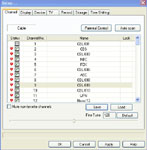 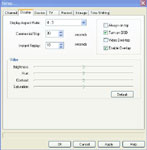
The above right image allows for adjustment of the display settings, including the basic brightness, hue, contrast, and saturation properties, as well as setting the aspect ratio of the window itself.
The next two screen captures are taken from the recording area of the setup controls. The software comes with three pre-programmed recording modes (Good, Better, Best), as well as allowing for customization through the use of various CODECs, etc., which can be retained by saving your own profile. The below left screen shows the properties of a recording made at "Best" settings, and the below right image shows custom properties that can be attained while recording in MPEG-2 DVD format.
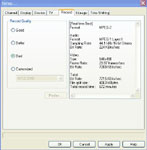 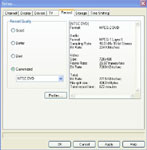
A closer look will be taken at recording later in the review, and will detail a few different recording modes and the resulting quality of the captures.
The below left screen would be comparable to setting your VCR or Tivo... The programming screen. On this screen, you can program that a certain show be taped whenever you want in the future, and even allows for that program to be taped every week in the same simple steps. By just entering the time, date, channel, and the frequency that you want it to be recorded, everything is taken care of.
 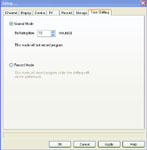
The above right screen capture shows the brief settings for time shifting... The ability to play and record live television, allowing you to pause the show you are watching and catch up again by skipping commercials, etc. A very nice feature if you only plan on being out of the room for a few minutes.
Testing / Use:
Installation was simple enough, and basic use of the Transcend TV-Box is equally easy. Whether using the remote control or the onscreen interface, the setup and navigation are relatively straight forward. Once familiar with the layout of the onscreen controls, it is easy to do exactly what you want, and the right mouse button reveals an extensive drop down menu that must have every control listed on it.
Over the past several years I have 'tried' 5 other TV tuners before the Transcend TV-Box arrived. Among the four PCI slot based cards (Packard Bell, ATI, Phoebe, and Leadtek) and one USB 1.1 card (Hauppauge) I have used, I have developed a pretty good idea of what to expect, what the general limitations are, and what makes for decent software. I say I have tried 5 other TV tuners, as some didn't even stay in my system one day as the performance/features were so poor. So, the TV-Box is up against some varied historical data as a source of comparison, but most of my remarks will be based on my experience with the Leadtek WinFast TV 2000 XP Deluxe PCI card which has been a mainstay in my system for close to two years.
Basically, the testing consisted of using the TV-Box as an average user might. Checking out the quality of features such as TV image, TV sound, still image captures, and video captures.
In my opinion. the TV playback was as good as the Leadtek WinFast TV2000 XP, which I have been quite impressed with for years. When you take a window to full screen it gets a bit grainy and washed out, but that seems to be a universal feature of TV tuners. At 320x240, 640x480, or any other comparable size, the image is clear and crisp and the general quality is higher than that of my standard tube televisions. My previous USB TV tuner (only USB 1.1 compliant) had terrible image quality, and shows would be jerky and fuzzy with nothing else on the computer running. The current test computer is always running Folding@Home, so there is no rest for the processor, and the TV quality is still very enjoyable.
The audio features of previous tuner cards is another area where I have been disappointed in the past... But not on the TV-Box USB 2.0. The sound was clear and even while using a decent set of headphones I could not detect a significant level of hiss, which I can not say for some other tuner cards. The highs were very crisp, and although the bass was a little weak, that could be remedied through the soundcard's equalizer. Stereo separation was decent too, but being that it is limited to 2 channel stereo, taking it to 5.1 or beyond would obviously require some kind of synthetic processing... and what my sound card's software managed sounded pretty good.
The device utilizes the 1/8" stereo cable to output its signal directly to the line-in port on your soundcard, so hopefully you have one available. Many 5.1 soundcards require you to have either a line-in and mic jack or surround sound enabled, so this can be an issue for some. But, the Leadtek WinFast TV 200 XP is a PCI slot based tuner, and even it requires an external cable for sending stereo sound to the computer!
Please read on to the next page for more... Next
Page 1 | Page 2 | Page 3 | Home | Forum | Review Index
|
|
|
|